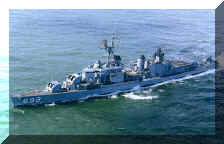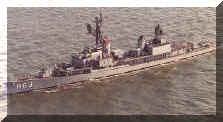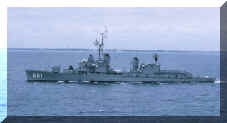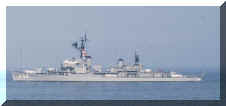
|
|
| ||||||||||||||||||||||||||||||||||||||||||||
|
|
With only 3 of the 175 Fletcher class Destroyers receiving a FRAM II Modernization at the Pearl Harbor Naval Shipyard in 1960 and yet another which operated DASH which had over 1000 landings by 1960, yet did not get FRAM, One has to wonder how that worked. It is explained here on our FLETCHER CLASS FRAM page. |
|
|
|
 |
When the Navy sought to improve upon the FLETCHER class destroyer, they did so by building upon the existing hull and machinery of the FLETCHER but added more firepower and capabilities. What emerged in May 1942 was the ALLEN M. SUMNER class of destroyer which weighed over 150 tons heavier and was 3 knots slower than the FLETCHER, yet was so versatile due to its size, the NAVY decided 33 of the remaining 53 SUMNERS needed to receive a FRAM "modernization" That history is here. |
|
|
|
|
|
With the added 150 tons, the SUMNER class was not only 3 knots slower than the FLETCHER class they were suppose to improve upon, the SUMNER also did not have the required range the Navy sought. To fix this major problem, the Naval design board proposed to lengthen future SUMNERs by an additional 14 feet for additional oil storage. This resulted in the creation of the GEARING Class destroyer and the NAVY sought the FRAM program for all 45 remaining destroyers, except 1. That history is here. |
|
|
|
 |
Between 1949-53 a special program saw the conversion of 36 GEARING class destroyers into long range-warning picket vessels. When these ships received their early warning radar systems, they became the FRANK KNOX class of DDRs. In 1960 when FRAM selection was occurring, the Navy decided to provide FRAM to all KNOX class DDRs yet not all became DDs in the process. Their reasons why is listed here. |
|
|
|
 |
When the Navy took eight GEARING class destroyers and outfitted them in December 1949 to become Hunter-Killer Destroyers, they created the Carpenter Class of DDKs. These ships were to form groups for the purpose of long and short-range interception of submarines before they could attack convoys. All these ships received FRAM- albeit it was not the same for all eight! Their history is here. |
|
|
|
 |
Although originally designed as GEARING class destroyers (DD), the Navy completed two as anti-submarine warfare (ASW) destroyer escorts (DDE) and then modified 5 other "4-gun Gearings" for the same mission. These ships became the BASILONE class DDE and by the time they all received their FRAM I reconstruction in July 1962, they all had been reclassified as DD. Their history is here. |
|
|
|
|
|
Originally conceived as an upgraded variant of the coastal escort, these DEALEY class destroyer escorts were fitted with the modern SQS-4 sonar and fire power of a FRAM II destroyer which gave them the capability to counter the fast Soviet Submarine threat. Of the 13 vessels, all but 3 received DASH as part of their FRAM modernization. Their history is here. |
|
|
|
|
|
Built from the Keel-up with all the FRAM improvements destroyers were receiving in 1960, the BRONSTEIN class of Destroyer Escorts were new construction but were part of the FRAM program to evaluate the feasibility of building into new vessels, the FRAM upgrades like the new weapon systems called ASROC and DASH and also incorporating the updated SQS-26 AX(R) sonar system to prosecute the targets these stand off weapon systems allowed for. While only two ships were built, this experiment was a success as these ships sail to this day! Their history is here. |
|
|
|
|
|
Although originally built for fast Carrier defense, the MITSCHER class of Destroyer Leaders forged several new paths for the U.S. Navy including the introduction of 1200 psi Steam plants, various configurations of machinery as well as sensors and weaponry that allowed for larger and faster destroyers to screen and protect fast carrier task forces. While only 4 ships were built, each was different to test specific variations of systems yet each received FRAM and each had DASH. Their history is here. |
|
|
|
|
|
The DASH Weapon system would never have been able to succeed, if it were not for the Destroyer Tenders that provided the heavy maintenance for the over 160 Fleet Destroyers that carried DASH. These floating workshops were massive: While a GEARING destroyer would have a crew complement of slightly over 300, a typical tender had over 3000 crew to man a ship some 5 times the size of a destroyer. We recognize these 17 ships here as DASH ships; for after their FRAM modernization, some Tenders carried 8 DASH drones at a time as a reserve for the destroyers they serviced. |
|
|
|
|
|
With the U.S. Navy stretched thin in the far east during the 60's and with the height of the cold war, it became clear that the Japanese Navy needed to expand its then-role of a simple coastal patrol force to that of being able to protect its own sea-lanes from Submarines. The U.S. Navy provided four Qh-50C/D aircraft to get the Japanese Maritime Self Defense Force (JMSDF) DASH program started. Here is the story of the Seven vessels of the JMSDF that carried DASH. |
We are currently working on the GARCIA class destroyer escorts to determine WHICH received FRAM. Further, how to classify the BELKNAP (DLG-26) and the NEW JERSEY (BB-62) which operated DASH but did not receive a complete DASH installation is a question.
![]()
![]()
|
The name "Gyrodyne" in its stylized
form above, is the Trademark of and owned by the Gyrodyne Helicopter Historical
Foundation; unauthorized use is PROHIBITED by Federal Law. All Photographs, technical specifications, and
content are herein copyrighted and owned exclusively by Gyrodyne Helicopter
Historical Foundation, unless otherwise stated. All Rights Reserved
©2013. |